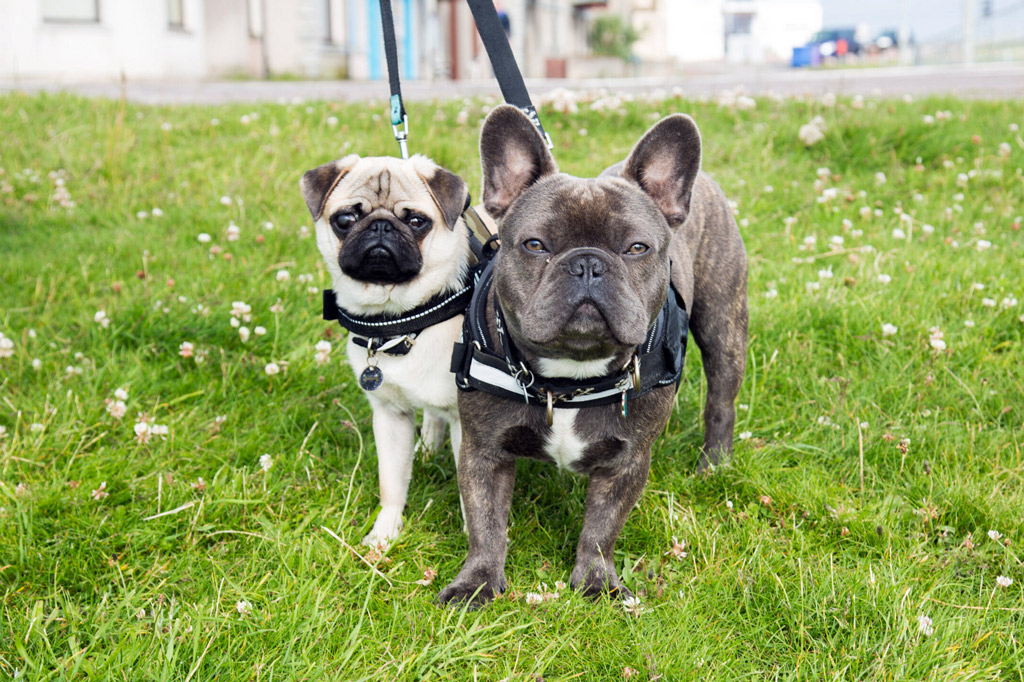
Pugs are a small-sized breed. Although some pugs can be bigger, skinnier, fatter, smaller or taller than others, they are more or less similar in size (if purebred). But, when are pugs full grown i.e. when do pugs stop growing?
Pugs are full-grown after 9 months when they stop growing, whether in weight or height. Pugs usually reach adulthood when they are 1 year old. Sexual maturity comes before physical maturity (6 to 9 months old).
Let’s see what to expect and get a bit into their growth stages.
Pug Growth Stages from Birth to Full Grown
Pugs are small dogs and they belong to the toy group.
Most pugs are born via cesarian (C-section) due to dystocia – a medical term used to diagnose a difficult birthing experience. Brachycephalic and toy breeds are predisposed to have a difficult birth because of the size of their head and narrow female pelvis.
Usually, a pug litter size is between 2 to 5 puppies, the average being 4 pups per litter.
Your pug will go through 5 puppy growth stages:
- The neonatal stage: Birth to 2 weeks of age.
- The transitional stage: 2 to 4 weeks of age.
- The socialization stage: 3 to 12 weeks of age.
- The ranking stage: 3 to 6 months of age.
- The adolescence stage: 6 to 18 months of age.
Here’s what to expect for each stage:
The Neonatal Stage (Birth to 2 Weeks)
During the neonatal stage:
- Puppies are blind, deaf, and toothless.
- Touch and taste are immediately present after birth.
- Their mother has the most influence over the puppy. She will feed them and keep them warm too.
- Puppies will mostly nurse and sleep during this stage.
The Transitional Stage (2 to 4 Weeks)
At the transitional stage:
- Their sense of hearing and smell will develop.
- Their eyes will open and will develop.
- Puppies teeth will begin to appear.
- Also, puppies will start to move. They begin to stand, take their first steps, wag their tail, and even bark.
- A puppy’s behaviour will be influenced by the mom and littermates.
The Socialization Stage (3 to 12 Weeks)
This stage is key for socialization, like the name indicates, and is the period when a puppy goes through rapid development.
During the socialization stage, the highlights are:
- By 3 to 5 weeks, play becomes important as puppies become aware of their surroundings.
- From weeks 3 to 4, pups develop control over their bladder and bowel movements. This is when they start learning to leave their sleeping area before relieving themselves.
- From 4 to 6 weeks, pug pups start learning dog social skills such as play, interaction with littermates, the inhibited bite, etc. Pups also explore their social boundaries, how to communicate effectively with other dogs and improve physical coordination.
- From the 4th week, puppies begin forming emotional attachments and bonds with the people around them. A good time to meet your future pup. 🙂
- By 5 to 7 weeks, a puppy needs positive human interaction as he or she develops curiosity and explores new experiences.
- Between 6 to 8 weeks, puppies should start receiving vaccinations (source: American Kennel Club).
- By week 8, puppies are fully weaned off their mother’s milk and eat solid food. After being fully weaned, pups start to be ready to leave their canine birth family and go to their new human homes.
- By 7 to 9 weeks, puppies can begin to be housetrained, including potty training.
- At 9 to 12 weeks, puppies can start learning basic commands as they start focusing on people (their new parents).
- Socialize your pug daily. Although the first 14 to 16 weeks of your puppy’s life can be considered to be your dog’s socialization period, it’s beneficial to keep exposing your pug to new things.
The Ranking Stage (3 to 6 Months)
At the ranking stage:
- Between 3 to 6 months of age, pugs start teething. It will last for several months.
- You are the main influencer for your pup.
The Adolescence Stage (6 to 18 Months)
The adolescence stage is the last development step:
- Between 6 to 9 months of age, sexual maturity in puppies typically occurs.
- After 9 months, growth slows down and by the age of 1, pugs reach adulthood and their full height.
Read also: Pug Teething Stages and 3 Tips to Stop Chewing.
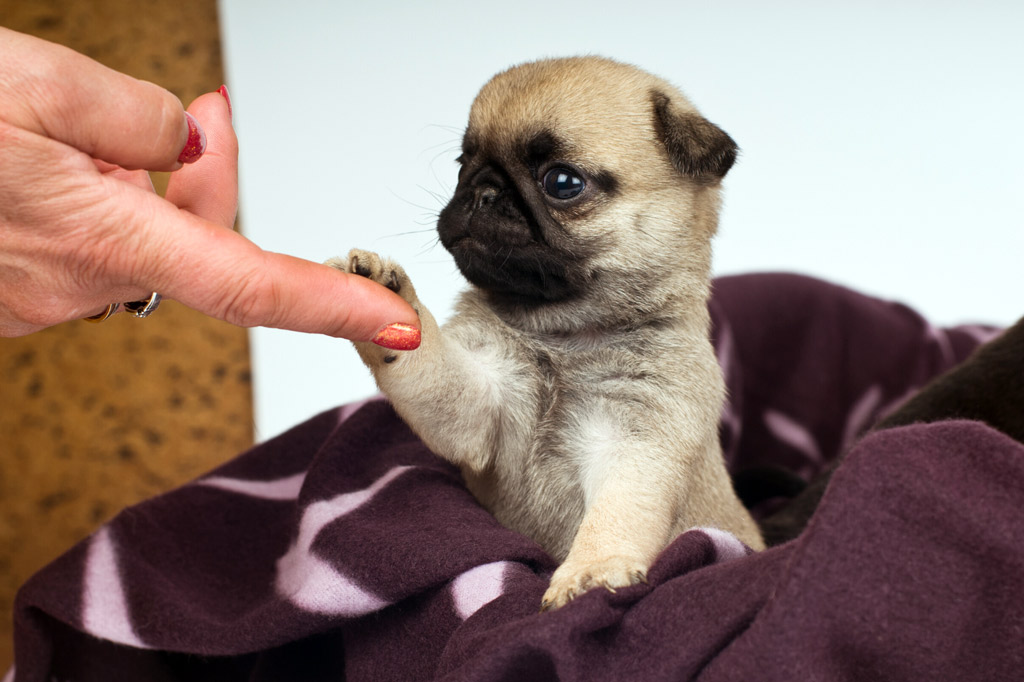
When Do Pugs Stop Growing?
After 9 months of age, pugs will stop growing and can be considered fully-grown whether in weight or height. By the time they are 1 year old, pugs reach adulthood.
Sexual maturity, on the other hand, usually comes before physical maturity. Female pugs go into their first heat cycle (known as estrous) when they are 6 to 9 months old. After that, female pugs are able to get pregnant.
Male pugs, however, generally gain full reproductive capabilities when they are between 6 months to 1 year old.
The pug breed is in his or her prime between 1.5 to 7 years. Afterwards, they will be considered senior dogs. Their life expectancy is between 13 to 15 years (source).
How Big Do Pugs Get When Fully Grown?
Pugs reach their full size around nine months of age and their growth slows down. You might not see big changes from 9 months old until they reach 1 year old, but some do continue filling out until they are a year old.
On average, pugs get 10 to 13 inches (25 to 33 cm) tall and weigh between 13 to 18 pounds
(5.89 to 8.16 kg) when fully grown.
If you got your Puggy from a breeder, you can always check with them since they can orient you about how big your pup will get by looking at both parents’ weight and size charts.
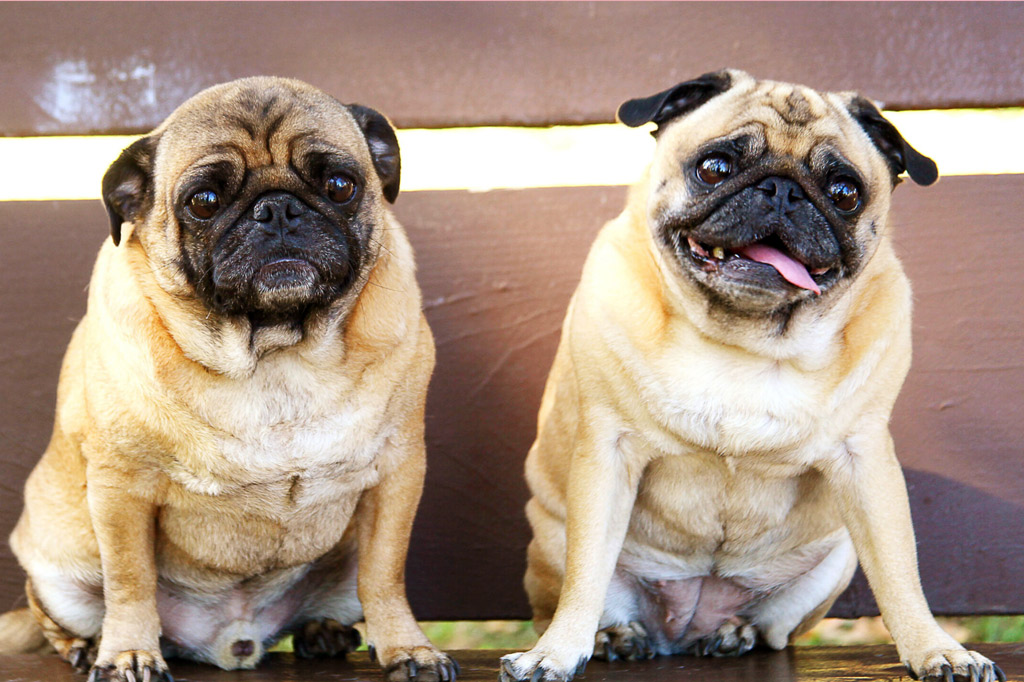
Pug Growth Chart
Mature pugs of both sexes are usually close in height and weight.
When fully grown, pugs are generally between 10 to 13 inches in height (25-33 cm).
According to the AKC breed standard, both male and female pugs should ideally weigh between 6.5 kg (14.3lb) and 8.5kg (17.6lb). Pugs outside of this range may be classed as under-weight and over-weight.
Check with your vet to get an accurate diagnosis since more athletic pugs will have bigger muscles and will weigh more.
However, if your pug starts looking like a big barrel, you should really start getting concerned. Check out our Is My Pug Overweight? An Obesity Check & 8 Weight Loss Tips blog post for further advice on this matter.
This chart will give you a guideline for what to expect regarding how fast your Pug grows and how quickly he will gain weight.
| PUG AGE | PUG HEIGHT | PUG WEIGHT |
|---|---|---|
| 8 weeks | * | 2-4 pounds (0.90-1.81 kg) |
| 6 months | 10-13 inches (25-33 cm) | 7-12 pounds (3.17-5.44 kg) |
| 1 year | 10-13 inches (25-33 cm) | 13-18 pounds (5.89-8.16 kg) |
Note that if you have a half-bred pug or cross-breed, your doggy’s size will be determined by both parents breed traits.
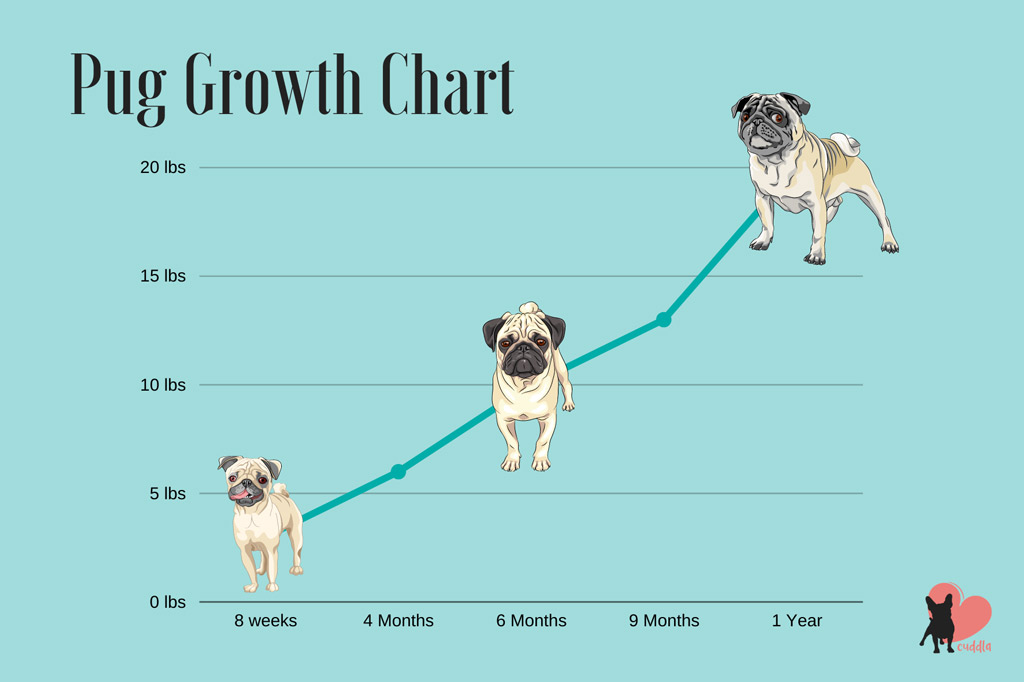
Using the Dog Size Calculator
The puppy growth calculator is powered by Omni Calculator, and they couldn’t make it any simpler! All you need is to fill in your puppy’s age and weight (choosing the metrics of your choice), and the dog weight estimator will process these details of your puppy to its adult weight.
Your dog’s adult weight will then be displayed as a range e.g. 13 – 18 lb, also telling you what size type your dog will be and what they can measure up to in height, from paw to shoulder e.g. 18 in (45.7 cm) of height.
Try it out below:
Teacup Pug Size
When researching the pug breed, I came across teacup pugs.
But, what is a teacup pug?
Teacup Pugs are not a recognized breed and are the result of breeding small size pugs and Teacup Chihuahuas. They are also known as Chug or Pughuahua.
Dwarfism is a genetic defect in dogs and is not a trait to be encouraged when breeding pugs (or any other breed, for the matter) since it prioritises aesthetics, not the dog’s health.
Breeding teacup or miniature pugs is unethical and also a harmful practice. These pugs have fragile health and are even more prone to developing serious health problems. Due to their poor health, teacup pug’s life expectancy is between 6 to 10 years.
So what size is a teacup pug?
Teacup Pugs can be as small as 1.5kg (3.3lb), literally small enough to fit in a teacup, hence the name. Usually, a full-grown adult will weigh 1.36- 4.50 kg (3-10lb) (source).
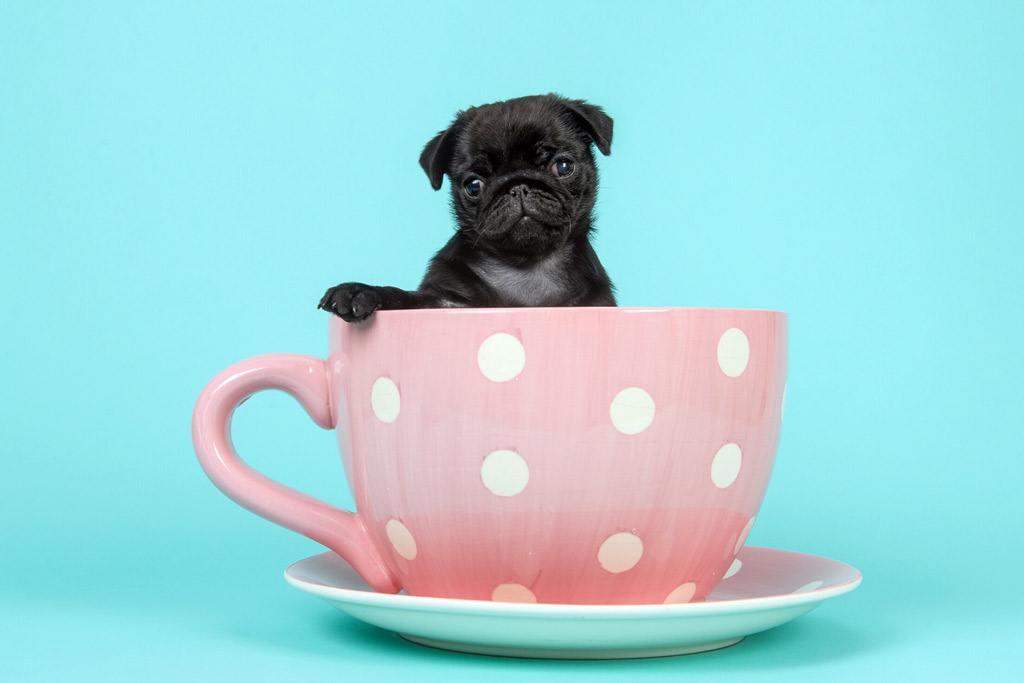
Pug Life Expectancy
Wondering what is the lifespan of the Pug breed?
Since Pugs are a smaller dog breed, they are likely to have a longer life expectancy than you would see in larger dog breeds.
Pugs life expectancy is between 13 to 15 years, but this will depend on how healthy your Pug is and whether he has developed any health conditions that might impair his life expectancy.
They are considered to be in their prime between the ages of 1 and 7, afterwards, they are considered seniors dogs.
Dogs Similar to Pugs
In terms of size, there are some breeds similar to pugs:
Boston Terrier vs Pug
The Boston Terrier has a much slimmer appearance mainly because they are taller than pugs, and are slightly lighter too.
Boston Terriers size varies a bit. Bostons weigh between 4.5 to 11 kg (9.92 to 24.25 lbs) and they measure between 15 to 17 inches (38.1 to 43.2cm) in height.
Find out more about Boston Terriers here.
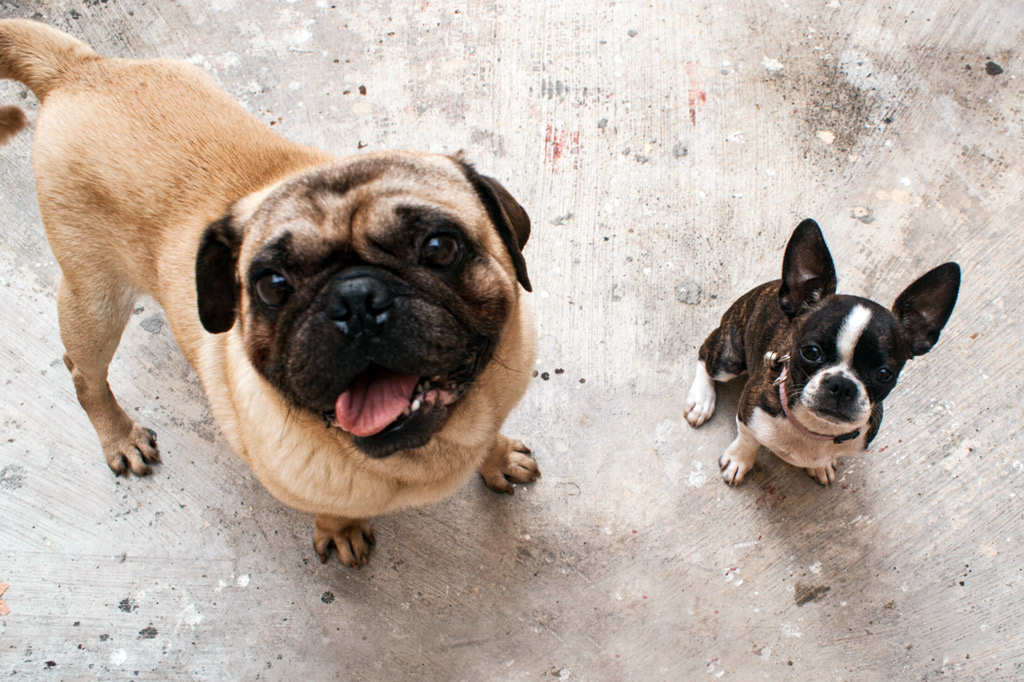
French Bulldog vs Pug
Both are very similar in height. Frenchies are slightly taller, between 11-13 inches (28-33 cm).
However, French Bulldogs weigh more than Pugs. On average, they weigh between 20 lb (9.1kg) to 28 lb (12.7kg).
